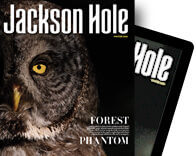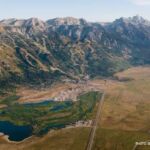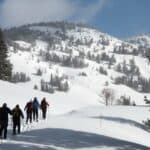Read The
Current Issue
Pawprints and Policy
In life, Grizzly 399 was a symbol of the species’ recovery under the Endangered Species Act. In death, can her legacy protect grizzlies as their time under federal protections seems to be coming to an end? And if it could, should it?
// By Billy Arnold
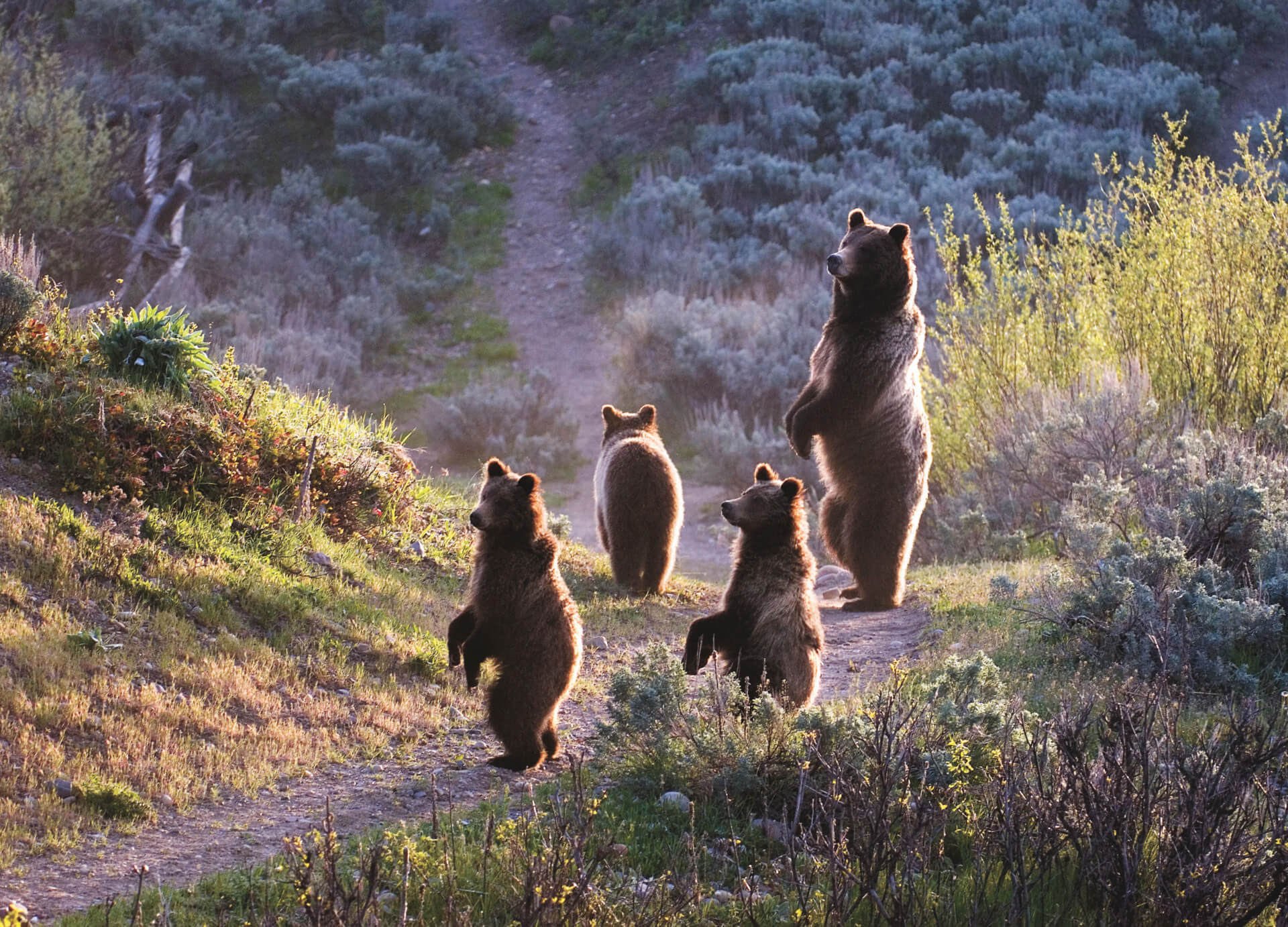
To the general public, her story began with the splat of grizzly feces, a tracking expedition, and the crinkle of fresh newsprint. The year was 2004, and Rebecca Huntington, a young reporter with the Jackson Hole News&Guide, was in the northern part of Grand Teton National Park following researchers who were tracking, but trying not to disturb, a young grizzly mother and her cub. Pushing through willows, they chronicled the bear’s diet of yampa roots, followed her tracks through smashed grass, and searched for an obvious tell: glistening piles of her scat.
“I vividly remember that day and being astounded that a grizzly could casually feast on these tiny roots next to a highway with thousands of people driving by and having no idea she was there,” Huntington says. She didn’t think the bear was unique. A bike path was being discussed for the area. “I just thought science and a recovering population were allowing us to see bears as they really are, a plant nibbler leaving a discarded trail of leafy tops.”
Huntington returned to the office and wrote a feature. At the time, the article was standard fare, a few hundred words explaining how GPS collaring was helping biologists track grizzly bears. But the article has become a critical piece in the history of the most famous grizzly in the world: Grizzly 399, the 28-year-old grizzly bear who raised 18 cubs along the roads in Teton park, attracted over 60,000 followers on her human Instagram account, and gave millions of bear lovers across the globe the opportunity to better understand how bears live in an ecosystem dominated by humans before dying in a vehicle strike in October 2024.
While wildlife managers eschew giving animals human names, when they collar animals for research, they do give them numbers, and the famous grizzly was the 399th collared in the Greater Yellowstone. Huntington’s article was the first time 399’s presence was ever publicized—two years before the sow caught the attention of wildlife watchers, bringing bear paparazzi to the Tetons to document her and her offspring’s lives for two decades. Perhaps more important, it shows 399 doing what made her a star: recolonizing the area south of Yellowstone National Park for grizzlies.
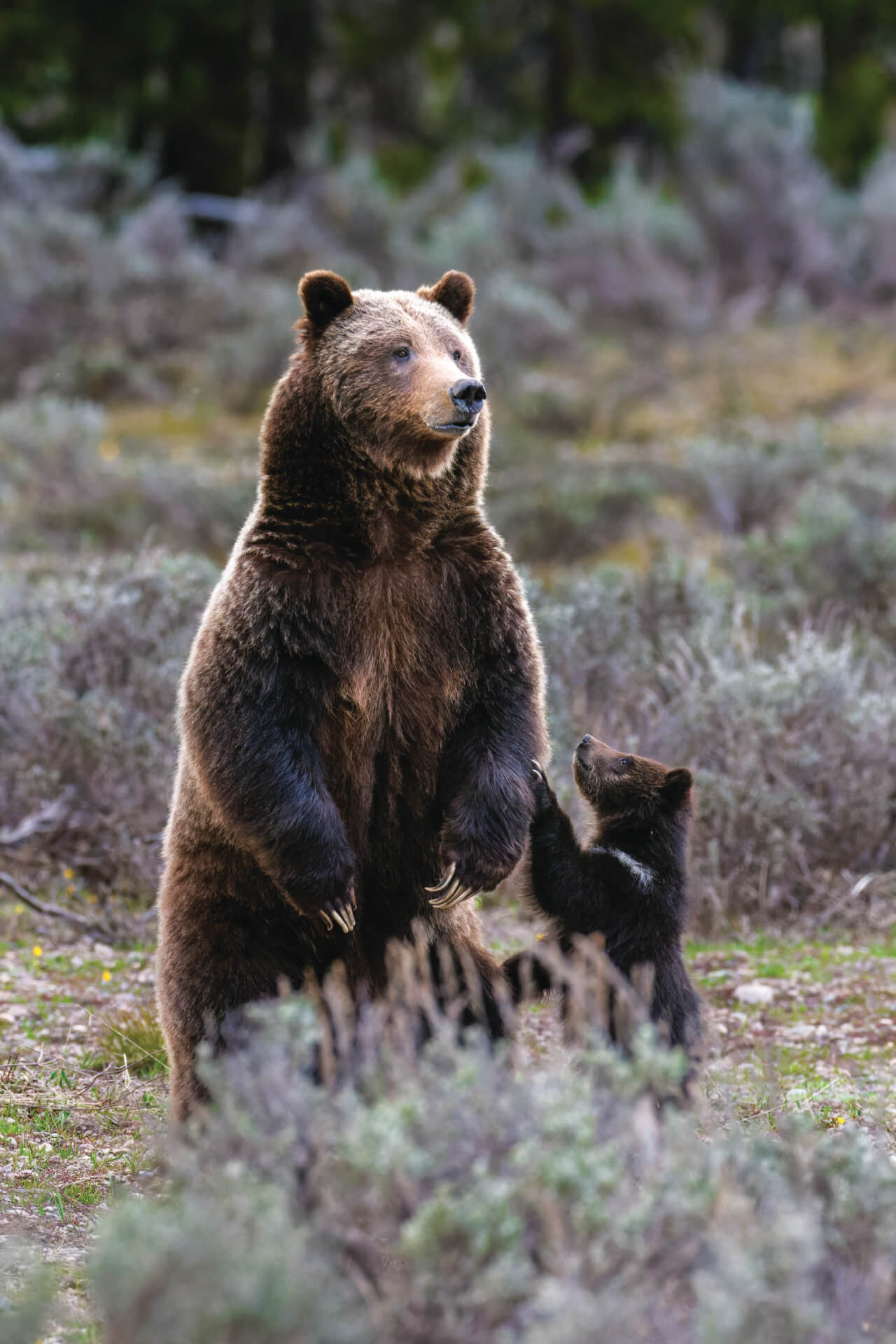
399 was the first grizzly to make herself consistently known, not only to GTNP rangers but also to the general public. In doing so, she became a symbol—not just of grizzly bears, but also of grizzly bears’ meandering path toward recovery.
Before European settlers arrived in North America, an estimated 50,000 grizzlies roamed the western United States, from the West Coast almost to the Mississippi River. But settlers saw bears as a threat to themselves and their cattle and sheep. Over the course of decades, grizzlies were eradicated from all but 2 percent of their historical homerange. By 1975, when the federal government protected grizzly bears under the Endangered Species Act, there were only an estimated 750 left in the Lower 48, with only 136 in the Greater Yellowstone Ecosystem, which includes Yellowstone and Grand Teton National Parks, the Wind River Reservation, portions of five national forests, three wildlife refuges, Bureau of Land Management land, and private land.
Endangered Species Act protection turned management of the bears over to the federal government and required state and federal wildlife biologists to develop plans for recovering the species. These state plans included a ban on hunting, required scientists to track grizzlies’ behaviors and deaths, and developed ways to prevent grizzly deaths while keeping humans safe.
Thirty years later, when Huntington tracked 399 through the willows near Jackson Lake Dam, the population had begun rebounding near Yellowstone National Park itself. Some grizzlies had moved through Grand Teton National Park, and a few had established home ranges there. But 399 was the first to make herself consistently known, not only to GTNP rangers but also to the general public.
In doing so, she became a symbol—not just of grizzly bears, but also of grizzly bears’ meandering path toward recovery. Last fall, she was struck and killed by a driver commuting on U.S. Highway 89/26 through the Snake River Canyon. The driver was neither speeding nor distracted. Nonetheless, 399’s death hit her fans around the world hard. It was quickly woven into the debate about grizzly bear conservation.
“She truly was an icon and an ambassador for not only her species, but also the wildness of the Greater Yellowstone Ecosystem. And I do think that it is important to remember and recognize that 399 is actually part of a larger, amazing conservation success story,” Grand Teton Superintendent Chip Jenkins said after the bear’s death. “Her ambassadorship is a story of the effort that many people, whether it’s private citizens or agency representatives, have done in terms of conserving grizzly bears as well as other wildlife in the Yellowstone ecosystem.”
But, in 2025, the year after 399’s death, and exactly 50 years after federal wildlife managers enshrined grizzlies’ Endangered Species Act protections, the species’ future is in question.
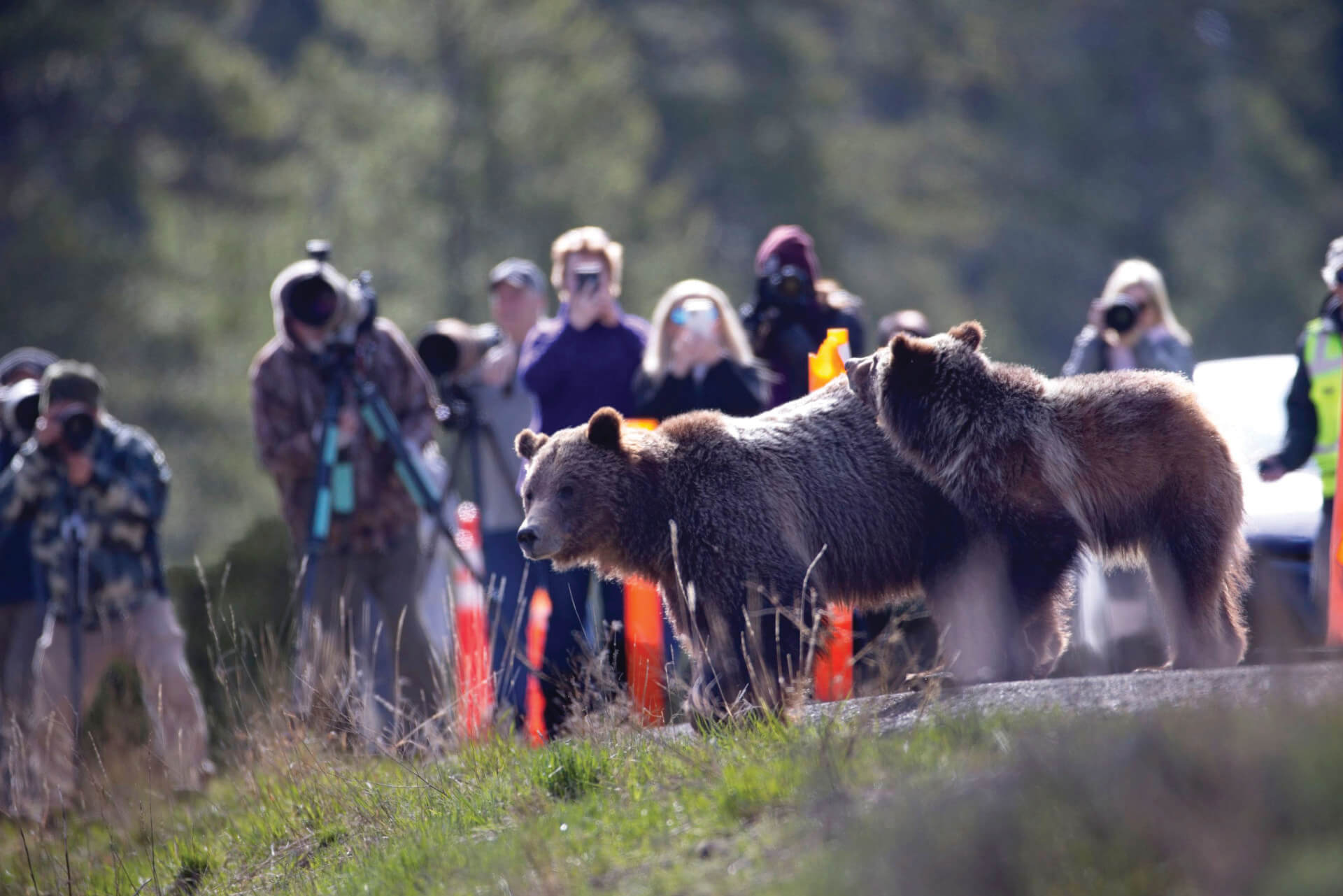
Symbol of Recovery
In the early 2000s, neither locals nor visitors saw many grizzly bears in the Tetons. Ask about seeing a grizzly at one of GTNP’s visitors centers, and the answer was something like, “You might see a grizzly bear in the northernmost canyons of the park—if you’re lucky.”
But in 2006, 399 strolled out of the forest near Oxbow Bend with three cubs and made that area home. Jackson-based wildlife photographers took pictures of the family, sold them at galleries, and posted them on social media, which was just beginning to take off. The story was unbeatable. Grizzly 399’s prominence compared to the bears that shirk human view meant that people could watch her over time and better understand how grizzlies lived. In the span of years, people saw her have cubs, teach them how to forage, keep them out of trouble, mourn when they died, and then kick them out and mate and start the whole process over again. They watched her dig for roots, pull fish out of a frozen river, and mate with boars (male grizzly bears) like Bruno, the name given by bear watchers to a grizzly believed to be one of 399’s frequent companions.
“We were just watching them, how they dealt with living in the park and how they lived,” says Sue Cedarholm, a wildlife photographer who followed 399 and the triplets in those early years. “People didn’t bother her. We were seeing her, how they function, and live and raise children.”
The bear’s presence in GTNP would have been improbable without the concerted recovery effort that began with the species’ listing on the Endangered Species Act. Through that process, the U.S. Fish & Wildlife Service, managers of public land like national forests, and state wildlife biologists developed a shared philosophy for managing the species. In addition to banning hunting; developing plans for managing bears that killed livestock and got into human-related foods, like garbage; and developing science-based policies to protect grizzly habitat far from human development, managers set up scientific study teams to understand where grizzlies were moving across the landscape. They closely tracked individual bear deaths, reproduction, and survival.
In the 1990s, wildlife managers developed three key metrics to gauge grizzlies’ recovery in the Greater Yellowstone Ecosystem: 1) a population of 500 or more bears, 2) an adequate distribution of female bears on the landscape, and 3) thresholds for the number of grizzlies that could die each year. By 2004, these criteria had been met six years in a row, and 399 was the living, highly photogenic proof.
“Here we have a reproducing female that is living there, having offspring. Her offspring are having offspring, and in a place where, in the early 1980s, there were no [grizzly] bears at all,” says Chris Servheen, who served as the U.S. Fish & Wildlife Service’s grizzly bear recovery coordinator for 35 years. “She’s very much evidence of recovery into the Jackson valley, Grand Teton, and south.”
In the span of years, people saw 399 have cubs, teach them how to forage, keep them out of trouble, mourn when they died, and then kick them out and mate and start the whole process over again.
And 399 stuck around, raising that litter of cubs along the side of the road. She kicked them off—bear-speak for becoming an empty nester—mated, gave birth in a den near Pilgrim Creek, and, in 2011, returned to the park roads with another set of triplets. Then another in 2013. Altogether, the matriarch birthed and raised 18 cubs alongside roads in the park between 2006 and 2024. (Biologists believe 399 raised her cubs along roads to protect the cubs from marauding boars. Male grizzlies will kill cubs to prevent competition and send mothers into heat, but most male grizzlies shy away from humans and roads.) It is estimated that about half of 399’s cubs survived to adulthood, giving her at least 12 grandcubs and two known great grandcubs—a significant contribution to the Teton area’s grizzly population.
Drawn to narratives about 399 and her offspring’s improbable survival, her human fan base grew. People made Instagram, Facebook, and Twitter pages where they spoke for her. Wildlife
watchers flew to the Tetons from across the globe, asking tour guides to show them the famous bear. And wildlife managers like Kate Wilmot, Grand Teton National Park’s branch manager of fish and wildlife, who started the park’s Bear Brigade, a coalition of staff and volunteers that manage bear jams to keep tourists away from grizzlies, scrambled to figure out how to manage the deluge of visitation to keep humans and 399 and her offspring safe. (The founding of the Bear Brigade was one such management tool.)
In the early days when 399 and her cubs were visible from the road, about 10 cars stopped to watch them. By 2020, when Grizzly 399 was at the peak of her popularity and emerged from the den with four cubs of the year—a feat documented only 11 other times in the Greater Yellowstone since scientists began tracking grizzlies closely—hundreds, if not thousands, of rabid wildlife watchers crowded the park, seeking her out. She wasn’t only the “Queen of the Tetons” but also the queen of bear jams. “She changed this place,” says wildlife guide Kurt Johnson. “She changed Grand Teton forever.”
Grizzly 399 and her popularity forced wildlife managers in the park to develop new policies for managing roadside bears and also for managing the people who flocked to the Tetons to see them. When she began venturing south and outside of the park’s borders in the later 2010s and found garbage, compost, and unsecured livestock feed to eat in the yards of homeowners—behaviors that other bears might have been killed for (to protect humans)—local governments adopted new bear-resistant trash cans. She led state wildlife managers to tweak policies about proposed grizzly hunts.
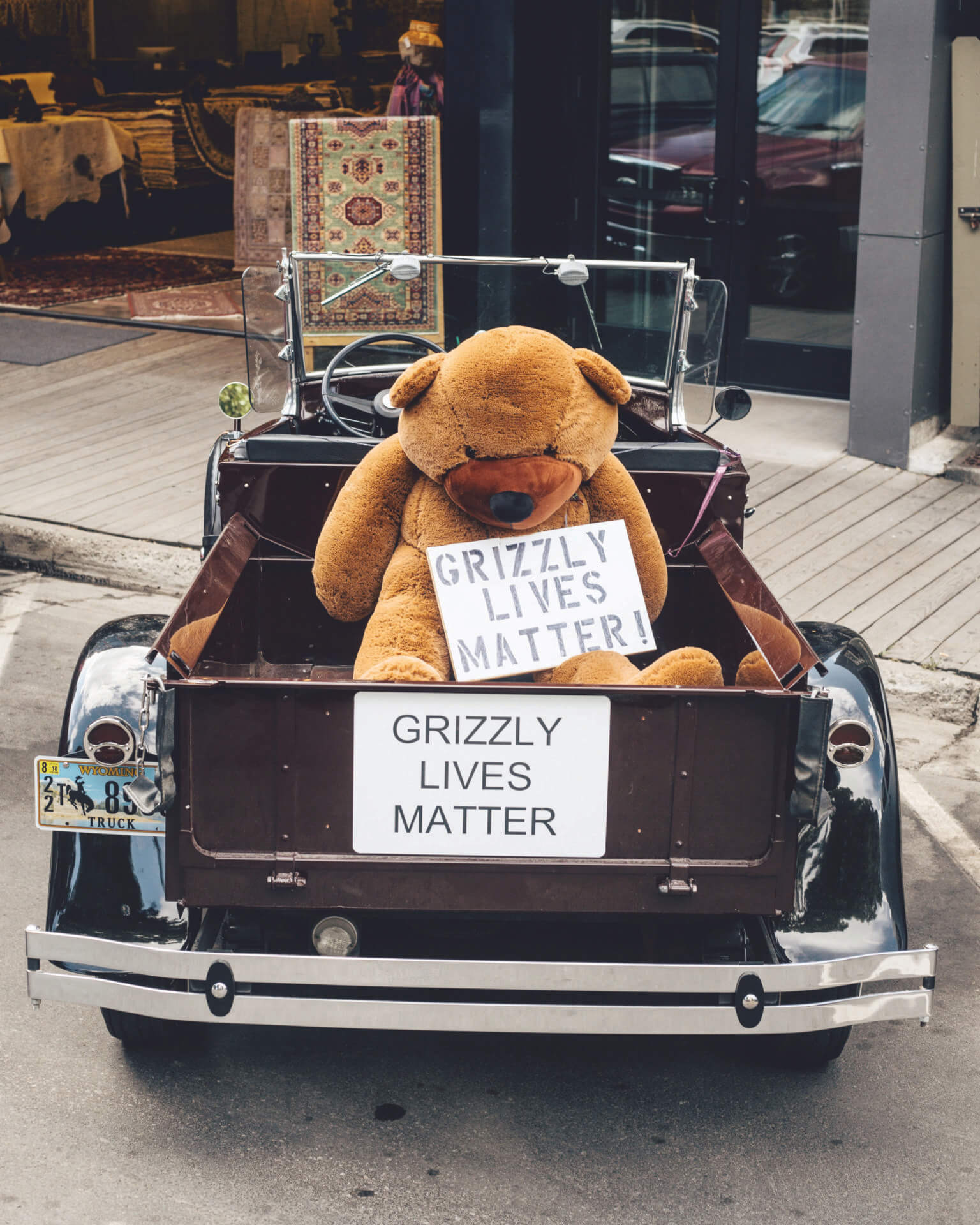
Ready for Delisting?
In 2017, federal land managers decided that grizzlies had fully recovered and no longer needed the protection of the Endangered Species Act. By that point, the recovery criteria established in the 1990s had been met annually for well over a decade. The species was removed from the endangered species list, and the U.S. Fish & Wildlife Service turned the management of grizzlies over to states. This meant changes in how the species was managed. But mostly it meant that states could authorize grizzly hunts for the first time in over four decades.
Wildlife advocates and some Native American Tribes didn’t agree that the species had recovered, and
sued, making the case that the service had ignored the best-available science about grizzlies’ diets and genetic health, among other legal arguments on the alleged misapplication of the Endangered Species Act. Some of the species’ main food sources— cutthroat trout and seeds produced by whitebark pines—were themselves imperiled by climate change, advocates argued. (Whitebark pine trees were listed as “threatened” under the Endangered Species Act in January 2023.) They also made the case that grizzlies in the Greater Yellowstone, isolated from other grizzly populations, didn’t have strong enough genetics to avoid inbreeding without connecting to other bears. Tribes, meanwhile, said the decision ignored their rights to consultation and their longstanding religious beliefs elevating the significance of grizzlies.
Notwithstanding the lawsuit, in May 2018, the Wyoming Game and Fish Commission, a board appointed by Gov. Mark Gordon that oversees the state game agency of the same name, approved a grizzly hunt. The commission believed the population of the species to be high and that hunting was a way to decrease it. Wyoming’s first grizzly hunt in 44 years was set to take place in September 2018.
At that time, 399 was 21 years old and more of an ambassador for the species than ever. In 2011 she had gone from a local icon to a global star. That spring she emerged from her den with a litter of three cubs while a daughter from her 2006 litter of triplets, Grizzly 610, emerged with two cubs of her own. Biologists aren’t sure why, but 610 adopted one of 399’s triplets. Both mothers and all five cubs were around park roads all summer. The “adoption” was covered by newspapers as far away as London and Turkey.
Cognizant of 399’s global renown while developing proposals for the hunt, the Wyoming Game & Fish Department established a buffer zone in the Bridger-Teton National Forest on the east side of GTNP where hunting grizzlies would be prohibited. The area was known to be frequented by Grizzly 399. Here, hunters could not harvest grizzlies. (GTNP, by virtue of being a national park, was already off limits.) “That ‘no hunt’ area was based on all known locations of that particular bear,” Dan Thompson, large carnivore supervisor for the Game & Fish department, previously told the News&Guide.
But the buffer zone wasn’t enough for wildlife advocates and 399’s fans. The “Shoot ’em with a Camera” movement was born. When Game & Fish opened the application process for the September hunt, photographers and nonhunters, concerned about a bear like 399 being killed just outside Grand Teton National Park’s borders, applied in droves. The goal was to keep grizzly tags out of actual hunters’ hands. “I have already applied,” organizer Judy Hofflund told the News&Guide at the time. “As has everybody in my family and everybody I can get my hands on.”
Hofflund didn’t draw a tag, but wildlife photographer Tom Mangelsen, the photographer best known for documenting 399’s life, did. Mangelsen beat out 3,500 Wyoming residents and 2,327 nonresidents for a tag that he would not use. In total, Game & Fish issued 22 tags. Two went to members of the “Shoot ’em with a Camera” movement.
But Mangelsen’s odds-defying draw ended up being moot. Days before the hunt was supposed to start, a federal judge intervened and ruled on the lawsuits filed by environmental groups and tribes. The judge found merit in the arguments against removing grizzlies from federal protection. The hunt was cancelled, and Wyoming, Montana, and Idaho were required to revisit their plans for ensuring the species’ genetic diversity and counting bears.

Looking to the Future
Seven years later, the fight for grizzly bears’ futures still rages. In the waning days of the Biden administration, the U.S. Fish & Wildlife Service decided against removing grizzly bears’ Endangered Species Act protections, enraging Western governors. Now, officials in the Trump administration have pledged to work with states to remove the bears’ protections. But wildlife advocates are resolute. Many don’t want to see grizzly protections removed, ever. They don’t trust states to manage the bears—and they certainly don’t trust states’ plans to hunt them.
Many of 399’s fans fall into this camp, like Jack Bayles, who spent 10 years in the military, 7 years as an ER tech, and 13 years as a cop. He describes 399 as his “salvation.” At a memorial after her death, he was clear. “We have to keep them listed, whatever that takes,” he said. Had grizzlies’ protections been removed and 399 ventured as far afield as she did when she died — the farthest south she’d ever been, notable for a bear that often ventured far outside of her traditional home range—it could have been hunters’ bullets, not a commuter’s car, that killed her. Bayles doesn’t think that’s an appropriate fate for a grizzly, let alone a famous bear like 399.
But other wildlife advocates say they do, eventually, want to see grizzly bears’ protections removed—when recovery is complete, and human communities have adequately prepared themselves to deal with grizzly bear reoccupation. They just don’t think the time is right now. “The goal is to get the species off the list and in a position where they’re not endangered anymore. There is no advocate, I would say, who wants them permanently listed,” says Kristin Combs, executive director of Wyoming Wildlife Advocates.
The U.S. Fish & Wildlife Service, however, wasn’t focused on bears like 399, or even hunting, which state and some federal wildlife biologists say the species can tolerate. Instead, the agency’s decision was bigger picture, focused on the entire Western United States rather than the Greater Yellowstone Ecosystem. The argument against delisting grizzly bears, the service says, is about allowing isolated populations of grizzlies in the GYE, the Northern Continental Divide Ecosystem surrounding Glacier National Park, and the Bitterroot Mountains, which grizzly bears haven’t yet been able to recolonize, to connect.
“For bears to be successful, and many other animals to be successful in the face of climate change, they’re going to need to move across the landscape because they may have to go places they didn’t have to go before.”
—Chris Servheen, retired U.S. Fish & Wildlife Service grizzly bear recovery coordinator
As it stands, each of these areas is managed independently, but the the Biden-era Fish & Wildlife Service proposed managing grizzlies as a big, interconnected population—something that’s now possible because the bears’ numbers have climbed and they’ve been frequently detected outside the heart of the Greater Yellowstone and Northern Continental Divide Ecosystems. In areas that grizzlies are likely to occupy, federal wildlife biologists proposed protecting them by preventing hunting, promoting bear-safe communities, and closely regulating states’ killing and removal of bears that get into trouble (like getting into trash or having come to associate humans with food). In areas that grizzlies are not likely to recolonize, the idea was to relax protections and allow states discretion over handling the bears.
Advocates like Combs are generally on board with the service’s proposal. “The problem is that the recovery plan was written in 1993. It’s outdated and focused on these island populations,” she says. “We need to see that the threats they’re under from climate change, human development, and human mortality are better before they move toward delisting.”
The proposal closely mirrors one submitted by Servheen, the U.S. Fish & Wildlife Service’s former grizzly bear recovery coordinator. Thinking about grizzlies as a large interconnected population will have three benefits, he says: It will allow them to move freely across the landscape and recolonize new areas. That will allow different populations to interbreed, improve their genetics, and avoid inbreeding. It will also make them more resilient to climate change. “For bears to be successful, and many other animals to be successful, they’re going to need to move across the landscape because they may have to go places they didn’t have to go before,” Servheen says.
States, however, have accused the federal government of moving the goalpost on recovery, especially because the U.S. Fish & Wildlife Service itself admits that previous markers of recovery have been met and because Wyoming, Montana, and Idaho took significant steps to demonstrate their dedication to protecting bears. The states have signed onto a plan with federal land managers and biologists to manage grizzly bears after their protections are removed. They’ve relocated bears from the Northern Continental Divide into the Greater Yellowstone to address genetic concerns. They’ve created an agreement that establishes a grizzly bear population target in the GYE and regulates hunting to ensure the species’ survival in its core range. In more far-flung areas, managers want less-strict regulations on grizzly populations so they have more flexibility to kill bears that cause conflicts with livestock or threaten people. Instead, they see the Fish & Wildlife Service’s decision-making as a folly and they’ve turned to the Trump administration and Republican lawmakers in the U.S. Congress, including Wyoming’s Harriet Hageman, to remove bears’ protections and hand management to states.
“This is not a science-based decision. It is a decision based on federal government not wanting to give up control,” says Angi Bruce, the director of the Wyoming Game & Fish Department. She feels that connecting populations, given human development in the West, is unlikely. The proposed area for grizzly protection “includes large areas of unsustainable habitat, including private lands in human-populated areas, which makes it very unlikely for connectivity to occur.”
But, like 399 fans and grizzly advocates such as Bayles, Servheen doesn’t trust the Western states, and particularly state legislatures, that have moved their own goal posts by opening the doors for hunters to target other carnivores in ways that could impact grizzlies, like hound hunting black bears in Montana and Idaho (Wyoming doesn’t allow the practice) and trapping wolves over bait, which is allowed in Montana and Idaho, with restrictions, but banned in Wyoming’s portion of the Greater Yellowstone. In Wyoming, state lawmakers proposed allowing hunters outside of the Greater Yellowstone Ecosystem to target grizzlies for free if they purchase an elk tag. The bill died, but wildlife advocates worry about the message it sends. “They have moved the goal post by putting these mortality mechanisms for grizzly bears out there,” Servheen says of the Western states. “And this effort is not only as an effort to increase resiliency, but to minimize those mortality-causing mechanisms that were never there when the 1993 recovery plan was written.”
All that is to say the debate about delisting has become much more global than 399. Intentionally or not, the U.S. Fish & Wildlife Service’s decision, which is likely to be overturned, changed the debate from an ecosystem-specific discussion where 399 could be a major player to a West-wide fight where celebrity bears are only part of the picture. Still, her supporters think that 399’s increasingly famous offspring or celebrity bears that traverse through areas that grizzlies don’t currently occupy will be pivotal in the next debate. “Because people feel so connected to these animals and love to see them so much, I think celebrity bears, wherever they are, will continue to be important and continue to be the focal point for people to learn about this issue and that bears are still struggling,” says Combs.
And, in a way, 399’s story is unmistakably tied to the ongoing debates, even if the focus shifts elsewhere. As a vanguard for her species, the first of her kind to visibly take up residence on the side of the road in Grand Teton National Park, decades after grizzlies had been all but removed from that landscape, she was a harbinger of grizzlies’ expansion and recovery—not just in the Greater Yellowstone, but across the American West. The question, now, is what to do with it.
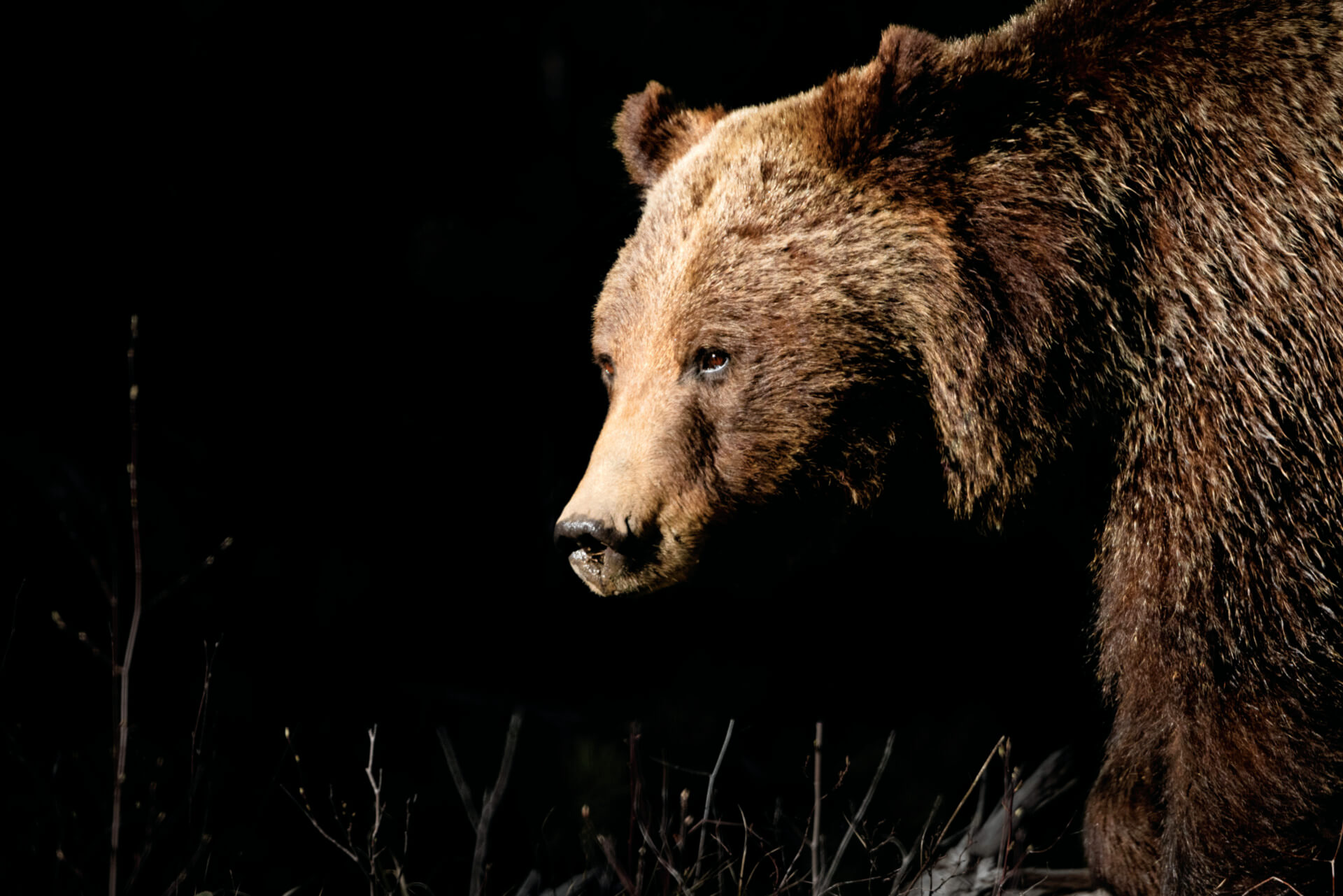
Since 1975, when the U.S. Fish & Wildlife Service first protected grizzly bears under the Endangered Species Act, they have been considered “threatened,” a lower level of threat than an “endangered” designation. “Endangered” species are in danger of extinction throughout all or a significant portion of their range. “Threatened” species, by contrast, are likely to become endangered within the foreseeable future. Over time, conservationists have tried to elevate various grizzly populations’ status from “threatened” to “endangered,” but the U.S. Fish & Wildlife Service has never agreed, either because science didn’t back the push, or because of limited resources.
As a “threatened” species, grizzlies have a handful of key protections:
• Grizzlies cannot be hunted, harmed, harassed, or killed, except in self-defense.
•The Endangered Species Act prohibits the import, commercial export, commercial transportation, sale, or take of grizzly bears in the Lower 48 states.
•While grizzly bears can be killed for preying on livestock or becoming food-conditioned and habituated to human presence, state wildlife managers are required to consult with the U.S. Fish & Wildlife Service before moving a bear to a new location or killing it.
•Notably, federal and state employees are “allowed to pursue, capture, collect, and import grizzly bears and to possess, move, or export unlawfully taken grizzly bears, so long as those activities are for scientific or educational purposes,” according to the Congressional Research Services.
1973
President Richard Nixon signs the Endangered Species Act into law.
1975
Grizzly bears are listed as “threatened” under the Endangered Species Act. At the time, only about 750 grizzlies—about 130 in Wyoming—remained in the Lower 48 states.
1993
Grizzly bear managers adopt a new recovery plan for grizzly bears, choosing to manage them in six isolated islands. Only four of the six populations are occupied.
1996
Grizzly 399 is born. Where, exactly, is unclear.
2001
The Interagency Grizzly Bear Study Team collars 399 for research.
2004
A Jackson Hole News&Guide reporter and researchers track 399 in Grand Teton National Park, the first time 399 is ever mentioned in the news. At the time, she has one cub.
2006
Grizzly 399 visibly raises a litter of three cubs in GTNP, becoming the first grizzly reguarly observed living south of Yellowstone National Park since the species was listed as threatened.
2007
The U.S. Fish & Wildlife Service, which manages “threatened” species like grizzlies, removes the bears’ Endangered Species Act protections. States vow to challenge the decision.
2009
A federal judge overturns the service’s decision, restoring grizzlies’ protections.
2011
399 has three cubs. One is adopted by her daughter, Grizzly 610, and the two moms raise their combined five cubs within view of GTNP roads. The adoption is covered by newspapers around the world.
2017
The U.S. Fish & Wildlife Service once again removes grizzlies’ protections, arguing the species is recovered. Multiple lawsuits are filed challenging this decision.
2018
The Wyoming Game & Fish Department approves a grizzly bear hunt. 399 inspires the “Shoot ’em with a Camera” campaign. A judge relists the bears before the hunt happens, though.
2020
Grizzly 399 emerges from the den with four cubs, an incredibly rare phenomenon in the ursine kingdom. At the height of the COVID-19 pandemic, the event propels her stardom.
2022
Wyoming, Montana, and Idaho petition the U.S. Fish & Wildlife Service once again to remove grizzly bears’ Endangered Species Act protections.
2023
Grizzly 399 emerges from the den with one cub, becoming the oldest known grizzly mother in the Greater Yellowstone Ecosystem.
2024
A commuter hits and kills 399 in the Snake River Canyon, prompting bear funerals and mourning from Israel to the United States to South Africa.
2025
The Fish & Wildlife Service decides against delisting grizzlies, arguing the bears need to be protected as they move between island populations. States vow to challenge the decision. JH
